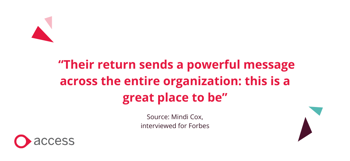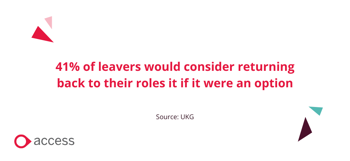
What are boomerang employees?
A boomerang employee is an employee who leaves a company for personal or professional reasons, then later returns to work for the company as a rehired employee. These individuals represent a growing segment of the workforce.
What makes boomerang employees particularly valuable is their unique position as individuals who understand your company culture, possess institutional knowledge, and return with additional experience gained elsewhere.
Boomerang employees bring unique value as advocates because they've experienced both your organisation and alternatives in the marketplace. Their decision to return serves as a powerful endorsement of your company's strengths. Brian Robinson of Forbes interviewed Mindi Cox, chief people office at O.C. Tanner and she notes this about boomerang employees: “Their return sends a powerful message across the entire organization: this is a great place to be [...] If you openly celebrate and welcome these employees, they can become ambassadors for fostering loyalty and cultivating a high-tenure workforce that’s committed to mutual success.”

What are the benefits of boomerang employees?
The strategic value of boomerang employees extends far beyond basic recruitment advantages. For larger organisations, these returning professionals represent a sophisticated talent strategy that could deliver measurable improvements across multiple HR metrics.
Research by UKG indicates that 41% of leavers would consider returning back to their roles it if it were an option. Similarly, 60% of managers believe employees made the wrong decision in leaving their roles, and 72% feel these departed employees would consider returning within the year. The benefits of boomerang employees are multi-faceted and bring advantages across the organisation.
Accelerated time-to-productivity
Boomerang employees typically achieve full productivity faster than new external hires, which can be a significant advantage in project-driven environments where time-to-impact is critical. This acceleration occurs because returning employees already understand your organisational processes, technology systems, and stakeholder relationships.
The cost implications for larger organisations can be substantial. Returning employees require minimal systems training and orientation, reducing both direct training costs and the productivity impact on existing staff who typically support new hire integration. This efficiency becomes particularly valuable during peak project periods when team capacity constraints could affect deliverables.
Depending on the timeframe, boomerang employees could re-integrate into team dynamics as well as their coworkers may still be with the company.
Cultural alignment with fresh perspect
The most valuable boomerang employees bring a unique balance to the organisation. They maintain cultural fluency whilst bringing external insights that could drive innovation. This combination can address a common challenge in established organisations. Ingrained knowledge and culture could be a barrier to innovation, but a fresh perspective can change that.
Returning employees often serve as effective change agents because they understand both the organisation's resistance points and possess external experience to propose solutions. Successful cultural integration frequently occurs when returning employees assume mentoring or cross-functional leadership roles. A boomerang employee who returns to lead a digital transformation initiative, for example, brings both knowledge about historical challenges and a fresh expertise.
Enhanced employer branding
Boomerang employees serve as powerful validators of your organisation's evolution and commitment to employee development. Their decision to return signals to the broader market that your company culture has genuine staying power and continues to attract talent even after employees have explored alternatives.
This validation extends beyond external perception to impact current employee retention. When colleagues see respected former team members choosing to return, it reinforces the organisation's value proposition and could reduce turnover amongst existing staff.
The alumni network effect creates a sophisticated talent pipeline. Discover how to create a corporate alumni network through employee advocacy in our blog ‘How to improve employee advocacy - turning leavers into brand ambassadors’.
Moreover, boomerang employees frequently become influential advocates within their professional communities, sharing positive experiences about organisational growth and leadership development. This organic employer branding could be particularly valuable in competitive talent markets where authentic employee testimonials carry significant weight with prospective candidates. Pairing organic branding with an effective branding strategy can give you a strong employer value proposition; for a detailed template on how to build a branding strategy, download our ‘Employer Branding Strategy Guide’.

Boomerang employee statistics that matter
The Harvard Business Review article The Promise (and Risk) of Boomerang Employees gives the following boomerang employee statistics:
- 28% of “new hires” were boomerangs who had resigned within the last 36 months
- Boomerang employees accounted for an average of 33% of new hires in retail
- An average of 25% of new hires in manufacturing were boomerang employees
Retail and manufacturing sectors face challenges that can make recruitment and retention challenging. Recruiting boomerang employees can be one solution. For other tips and actionable strategies to address the skills gap and improve retention, download our ‘Guide to navigating HR tech challenges in retail, manufacturing and hospitality sectors’.
- An average of 14% of new hires in tech were boomerangs
- 26% of boomerang employees returned to their previous employers within seven months
- More than three-quarters of boomerangs returned by month 16
- The average pay raise for boomerang employees was 25%
- The average salary increases for employees who stayed at one company was 4%
When boomerang recruitment works (and when it doesn’t)
Success with boomerang employees depends heavily on making informed decisions about which former employees to welcome back and how to manage their reintegration effectively. Not every departure creates a suitable candidate for future rehiring.
Criteria for identifying suitable candidates
The most successful boomerang hires typically share several characteristics: they left on positive terms, maintained professional relationships during their absence, and return with demonstrable skills enhancement. The positive terms they leave on can be dictated by an effective and structures onboarding process.
Suitable candidates often demonstrate genuine enthusiasm for returning rather than simply seeking any available opportunity. They should articulate specific reasons for wanting to rejoin your organisation that go beyond basic job security or compensation.
Key considerations for evaluation
Beyond these positive indicators, consider the circumstances surrounding their original departure. The timing and manner of how they left can provide valuable insights into their professionalism and commitment. Candidates who followed proper procedures, maintained relationships with colleagues, and departed respectfully typically show the maturity that supports successful rehiring.
A structured offboarding process enables you to capture this valuable data systematically. With powerful people analytics embedded in PeopleXD Evo, you can identify patterns in successful rehires and use these insights to refine your evaluation criteria, helping you make more informed decisions about which former employees could thrive in your organisation again.
Managing the reintegration process
A structured decision-making framework could help evaluate potential boomerang candidates objectively. Developing criteria that assesses their previous performance, departure circumstances, external experience gained, and current organisational needs can be beneficial. Documentation then becomes crucial. Maintaining detailed exit interview records, performance evaluations, and notes about departure circumstances can help you make evidence-based decisions. Keeping those stored in a system like PeopleXD Evo allows you to recall and assess this documentation instantly. If you’re looking for ways to standardise processes like exit interviews, you can check out our blog ‘15 exit interview questions for successful offboarding - with free template’ and download the template.
Using modern HRIS systems to track corporate alumni engagement
Modern HR software systems could enhance your ability to manage boomerang recruitment effectively. These platforms can track alumni engagement through automated communication workflows, monitoring career progression, and identifying potential return candidates based on predetermined criteria.
Advanced HR systems allow you to maintain alumni databases with career milestone tracking, enabling proactive outreach when suitable opportunities arise. Automated engagement programmes could keep former employees connected to your organisation through newsletters, event invitations, or industry updates, maintaining positive relationships that facilitate future recruitment conversations.
Building a boomerang-friendly framework
Creating an effective boomerang recruitment strategy requires careful planning, design, and support. Successful strategies will consider former employees as expended talent networks rather than lost resources. Implementation begins with reimagining how departures are managed and extends through ongoing relationship maintenance. Modern HR systems could automate much of this process, from exit interview documentation to alumni communication workflows, creating scalable approaches that work for larger organisations.
Reimagining your offboarding process
Transforming your offboarding into a relationship-building opportunity rather than simply an administrative task can create positive experiences. For strategies on how to standardise your process and shift its perspective, read our ‘What is the offboarding process in HR?’ blog. Create positive exit experiences by conducting thorough handovers, celebrating contributions, and expressing genuine interest in maintaining professional connections. This approach signals that departures are viewed as career transitions rather than organisational failures.
Developing an alumni engagement strategy
Build sustainable networks through structured communication programmes that keep former employees connected to your organisation's evolution. Consider quarterly newsletters highlighting company achievements, industry insights, and career opportunities. Social media groups or professional networking events could maintain relationships whilst providing platforms for ongoing dialogue. Read more details about successful corporate alumni networks and how to build yours in our blog, ‘How to improve employee advocacy - turning leavers into brand ambassadors’.
Interview strategies for returning talent
Develop tailored assessment approaches that acknowledge both familiarity and change. Also look to address potential concerns directly. For example, discuss what motivated their return, how they've grown during their absence, and what they hope to contribute differently. This conversation helps establish realistic expectations. The most valuable returning employees bring fresh insights gained through external experience, so assess their ability to bridge old knowledge with new approaches.
Measuring success and ROI
Recruitment of boomerang employees and measuring their impact can encompass both immediate metrics and long-term impact. Track time-to-hire, cost-per-hire, and retention rates for boomerang employees compared to external hires, whilst monitoring quality of hire through performance evaluations and manager feedback.
Long-term impact assessment could include alumni engagement rates, referral quality from former employees, and the correlation between positive offboarding experiences and successful returns. Solutions like PeopleXD Evo, with its AI-powered analytics and unified HCM capabilities, can automate much of this tracking, providing real-time insights into recruitment patterns and helping identify which former employees represent the highest-value opportunities for future engagement.

 AU & NZ
AU & NZ
 SG
SG
 MY
MY
 US
US
 IE
IE